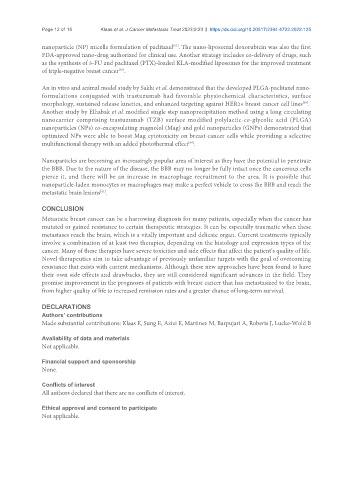Page 438 - Read Online
P. 438
Page 12 of 15 Klaas et al. J Cancer Metastasis Treat 2023;9:23 https://dx.doi.org/10.20517/2394-4722.2022.125
[57]
nanoparticle (NP) micelle formulation of paclitaxel . The nano-liposomal doxorubicin was also the first
FDA-approved nano-drug authorized for clinical use. Another strategy includes co-delivery of drugs, such
as the synthesis of 5-FU and paclitaxel (PTX)-loaded KLA-modified liposomes for the improved treatment
[58]
of triple-negative breast cancer .
An in vitro and animal model study by Sakhi et al. demonstrated that the developed PLGA-paclitaxel nano-
formulations conjugated with trastuzumab had favorable physiochemical characteristics, surface
morphology, sustained release kinetics, and enhanced targeting against HER2+ breast cancer cell lines .
[59]
Another study by Elhabak et al. modified single step nanoprecipitation method using a long circulating
nanocarrier comprising trastuzumab (TZB) surface modified polylactic-co-glycolic acid (PLGA)
nanoparticles (NPs) co-encapsulating magnolol (Mag) and gold nanoparticles (GNPs) demonstrated that
optimized NPs were able to boost Mag cytotoxicity on breast cancer cells while providing a selective
multifunctional therapy with an added photothermal effect .
[60]
Nanoparticles are becoming an increasingly popular area of interest as they have the potential to penetrate
the BBB. Due to the nature of the disease, the BBB may no longer be fully intact once the cancerous cells
pierce it, and there will be an increase in macrophage recruitment to the area. It is possible that
nanoparticle-laden monocytes or macrophages may make a perfect vehicle to cross the BBB and reach the
[61]
metastatic brain lesions .
CONCLUSION
Metastatic breast cancer can be a harrowing diagnosis for many patients, especially when the cancer has
mutated or gained resistance to certain therapeutic strategies. It can be especially traumatic when these
metastases reach the brain, which is a vitally important and delicate organ. Current treatments typically
involve a combination of at least two therapies, depending on the histology and expression types of the
cancer. Many of these therapies have severe toxicities and side effects that affect the patient’s quality of life.
Novel therapeutics aim to take advantage of previously unfamiliar targets with the goal of overcoming
resistance that exists with current mechanisms. Although these new approaches have been found to have
their own side effects and drawbacks, they are still considered significant advances in the field. They
promise improvement in the prognoses of patients with breast cancer that has metastasized to the brain,
from higher quality of life to increased remission rates and a greater chance of long-term survival.
DECLARATIONS
Authors’ contributions
Made substantial contributions: Klaas E, Sung E, Azizi E, Martinez M, Barpujari A, Roberts J, Lucke-Wold B
Availability of data and materials
Not applicable.
Financial support and sponsorship
None.
Conflicts of interest
All authors declared that there are no conflicts of interest.
Ethical approval and consent to participate
Not applicable.

